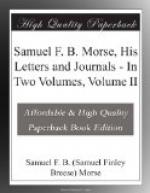On the 6th of October, 1818, the following notice appeared in the New Hampshire “Patriot,” of Concord: “Married in this town, October 1st, by Rev. Dr. McFarland, Mr. Samuel F.B. Morse (the celebrated painter) to Miss Lucretia Walker, daughter of Charles Walker, Esq.”
On the 5th of October the young man writes to his parents:—
“I was married, as I wrote you I should be, on Tuesday morning last. We set out at nine o’clock and reached Amherst over bad roads at night. The next day we continued our journey through Wilton to New Ipswich, eighteen miles over one of the worst roads I ever travelled, all uphill and down and very rocky, and no tavern on the road. We enquired at New Ipswich our best route to Northampton, where we intended to go to meet Mr. and Mrs. Cornelius, but we found on enquiry that there were nothing but cross-roads and these very bad, and no taverns where we could be comfortably accommodated. Our horse also was tired, so we thought our best way was to return. Accordingly the next day we started for Concord, and arrived on Friday evening safe home again.
“Lucretia wishes to spend this week with her friends, so that I shall return (Providence permitting) on this day week, and reach home by Tuesday noon, probably to dinner. We are both well and send a great deal of love to you all. Mr. and Mrs. Walker wish me to present their best respects to you. We had delightful weather for travelling, and got home just in season to escape Saturday’s rain.”
CHAPTER XI
NOVEMBER 19, 1818—MARCH 31, 1821.
Morse and his wife go to Charleston, South Carolina.—Hospitably entertained and many portraits painted.—Congratulates Allston on his election to the Royal Academy.—Receives commission to paint President Monroe.—Trouble in the parish at Charlestown.—Morse urges his parents to leave and come to Charleston.—Letters of John A. Alston.—Return to the North.—Birth of his first child.—Dr. Morse and his family decide to move to New Haven.—Morse goes to Washington.—Paints the President under difficulties.—Hospitalities.—Death of his grandfather.—Dr. Morse appointed Indian Commissioner.—Marriage of Morse’s future mother-in-law. —Charleston again.—Continued success.—Letters to Mrs. Ball.— Liberality of Mr. Alston.—Spends the summer in New Haven.—Returns to Charleston, but meets with poor success.—Assists in founding Academy of Arts, which has but a short life.—Goes North again.
The young couple decided to spend the winter in Charleston, South Carolina, where Morse had won a reputation the previous winter as an excellent portrait-painter, and where much good business awaited him.
The following letter was written to his parents:—
SCHOONER TONTINE, AT ANCHOR OFF CHARLESTON LIGHTHOUSE,
THURSDAY, November 19, 1818, 5 o’clock P.M.
We have arrived thus far on our voyage safely through the kind protection of Providence. We have had a very rough passage attended with many dangers and more fears, but have graciously been delivered from them all. It is seven days since we left New York. If you recollect that was the time of my last passage in this same vessel. She is an excellent vessel and has the best captain and accommodations in the trade.




